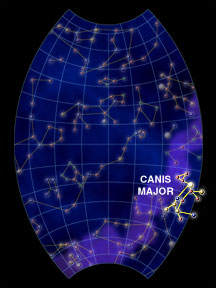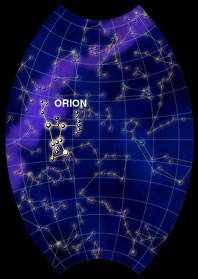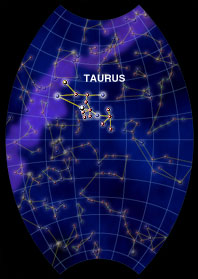Pick three star constellations from the hemisphere you live in. Give me the history or story behind it. With a picture.
Canis Major is known as the Great Dog. In Greek myth, it is said that this constellation, along with Canis Minor, are Orion's hunting dogs. Canis Major was one of the most important constellations in ancient times because the brightest star in the sky is part of it.
Sirius, the Dog Star, is one of the brightest objects in the night sky. Only the Moon, Venus, Jupiter and Mars are brighter. Those that lived near the Nile River used the star to signal the flooding of the Nile. This special occasion represented the return from the dead of the Sun god Osiris.
Canis Major is very easy to find during the months of November through March. First locate Orion the Hunter, and imagine a straight line through his belt. Follow the line to the southeast, and you will see Sirius perched right below it. Sirius is the nose of the dog. His body stretches to the southeast, and his front leg is to the west of Sirius.
I chose this constellation becuase there is nothing like a good hunting dog
Orion, the Hunter, is by far the most famous seasonal constellation. No other is more distinct or bright as this northern winter constellation. The famous Orion's Belt makes the hunter easy to find in the night sky.
Orion looks very much like a person. First, you should spot Orion's Belt, which is made of three bright stars in a straight line. One of Orion's legs is represented by the bright star Rigel, one of the brightest stars in the night sky. His two shoulders are made of the stars Bellatrix and Betelgeuse. You can see Betelgeuse's reddish color without a telescope. Other bright stars make up the two arms, one which holds a shield, and another that carries a club.
Many different civilizations saw this constellation in the sky. The most famous stories come from Greek and Roman myths. Orion was a famed hunter, and in one story boasted that no creature could kill him. Hera then sent a scorpion to sting the hunter. Orion smashed the animal with his club, but not before he was poisoned. Both are now on opposite sides of the sky. They cannot be seen at the same time.
A different story tells of the love between Orion and the goddess, Artemis. One day, Orion was swimming out in the sea. Apollo, who very much disliked the man, bet his sister that she couldn't hit the object in the sea with her bow. Artemis didn't realize it was her lover, and shot Orion with an arrow. When she later found out what she had done, she honored the hunter by putting him in the sky.
There are several clusters and nebulae to view in this awesome constellation. The famous Orion Nebula is located in Orion's sword, which hangs from the belt. It is so bright, that even the naked eye can see the fuzzy patch. It looks spectacular even with a small telescope or binoculars. There are numerous other objects in Orion, so scan the constellation with a telescope or binoculars on a clear night!
Taurus is commonly known as The Bull. It passes through the sky from November through March. Taurus was a very popular constellation in ancient times, so there are many myths about it.
The Greeks thought the stars represented Zeus in disguise as a white bull. He tricked Europa into climbing on his back. He then swam out to sea and carried her to Crete. In Egypt, the constellation was a reminder of Apis, the Bull of Memphis. He served as a servant to Osiris, god of the Sun.
Just as famous as Taurus is the group of stars within it. The Pleiades are a group of seven stars that lie on the Bull's shoulder. The Greeks believed these were the Seven Sisters, daughters of Atlas and Pleione. It was told that they asked Zeus to place them in the sky to escape Orion, who was desperately pursuing them. Little did they know that Orion would be placed right next to Taurus in the night sky!
The brightest star in Taurus is Aldebaran. It serves as the eye of the bull and is near the Hyades, a lesser known but still visible group of stars. The beautiful Crab Nebula is located above the tip of the bottom horn.



No comments:
Post a Comment